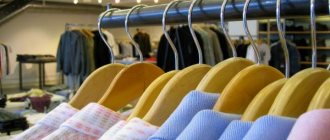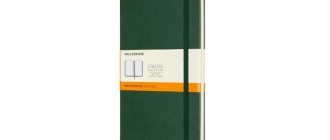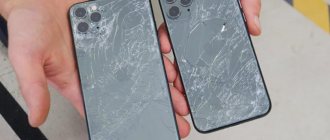The product does not always correspond to the declared quality or satisfy the wishes of customers. The purchase can be returned. The implementation of the process is regulated by Art. 25 of the Law “On Protection of Consumer Rights” . It is important to comply with the regulations. Otherwise, the return will not be possible. The PZPP establishes the time frame for completing the procedure. We will talk further about how to exchange or return goods, how to carry out the procedure correctly and what to do if a dispute arises.
Consumer rights
The current code states that the buyer has the right to exchange goods of appropriate quality within two weeks from the date of purchase. The corresponding provision is fixed in Article 502 of the Civil Code of the Russian Federation and Article 25 of the Law “On the Protection of Consumer Rights” (CPR). However, there are a number of limitations. They are recorded in Russian Government Decree No. 55. The document limits the list of goods that can be returned if the quality does not meet established requirements.
Note! The list is exhaustive. This means that items cannot be added to it at the discretion of the seller.
In the event that the buyer requires a refund or an exchange, the seller is obliged to carry out the procedure if the product has not been used and its consumer properties are preserved. Additionally, the person is required to provide a receipt or check. They confirm the fact of purchasing a product in a specific store. If at least one of the criteria is not met, the return cannot be performed.
There is no established procedure in current legislation for providing compensation for losses or costs incurred by the seller in connection with the return. In practice, the buyer may request an exchange, but the seller does not have a similar product. In this case, termination of the purchase and sale agreement is permissible. After this, the funds are returned.
Article 25. The consumer’s right to exchange goods of proper quality
1. The right to exchange goods of proper quality should be distinguished from consumer rights associated with the discovery of defects in goods. The basis for the emergence of consumer rights related to the discovery of defects in a product is a violation of his rights, expressed in the sale of a product of inadequate quality to him. The consumer has the right to exchange goods of proper quality, regardless of the violation of his rights.
The list of reasons on which a consumer can demand the exchange of goods of proper quality is exhaustive and closed: this is a discrepancy between the shape, dimensions, style, color, size or configuration of the goods and the wishes of the consumer. Other reasons cannot serve as a basis for satisfying the consumer’s request to replace a product of proper quality. Please remember that only non-food items can be exchanged.
This requirement can only be presented to the seller from whom the goods were purchased; neither the manufacturer, nor the importer, nor authorized representatives are required to satisfy such requirements.
The fourteen-day period provided by the commented norm to the consumer for the exchange of non-food goods of adequate quality cannot be suspended, its duration is not affected by circumstances related to the inability to use the goods.
According to the commented norm, the exchange of non-food goods of proper quality is carried out if the specified product has not been used, its presentation, consumer properties, seals, factory labels are preserved, and there is also a sales receipt or cash receipt or other document confirming payment for the specified product. The consumer’s absence of a sales receipt or cash receipt or other document confirming payment for the goods does not deprive him of the opportunity to refer to witness testimony.
The law in this case does not clarify whether the preservation and packaging of the goods should be understood, but in this case it should be understood as part of the presentation. The testimony of witnesses is not an unambiguous basis for satisfying the consumer’s requirements; they must be assessed in accordance with their reliability.
The list of non-food products of proper quality that cannot be returned or exchanged for a similar product of a different size, shape, dimension, style, color or configuration is approved by Decree of the Government of the Russian Federation of January 19, 1998 N 55. It includes the following categories of goods.
1. Goods for the prevention and treatment of diseases at home (sanitary and hygiene items made of metal, rubber, textiles and other materials, medical instruments, instruments and equipment, oral hygiene products, spectacle lenses, child care items, medicines) .
2. Personal hygiene items (toothbrushes, combs, hairpins, hair curlers, wigs, hairpieces and other similar products).
3. Perfume and cosmetic products.
4. Textile goods (cotton, linen, silk, wool and synthetic fabrics, goods made from non-woven materials such as fabrics - ribbons, braid, lace and others); cable products (wires, cords, cables); construction and finishing materials (linoleum, film, carpets and others) and other goods sold by the meter.
5. Sewing and knitted products (sewing and knitted linen products, hosiery products).
6. Products and materials in contact with food, made of polymeric materials, including for single use (tableware and kitchen utensils, containers and packaging materials for storing and transporting food products).
7. Household chemicals, pesticides and agrochemicals.
8. Household furniture (furniture sets and sets).
9. Products made of precious metals, with precious stones, made of precious metals with inserts of semi-precious and synthetic stones, cut precious stones.
10. Cars and motorbikes, trailers and numbered units for them; mobile means of small-scale mechanization of agricultural work; pleasure boats and other household watercraft.
11. Technically complex household goods for which warranty periods are established (household metal-cutting and woodworking machines; household electrical machines and appliances; household radio-electronic equipment; household computing and copying equipment; photographic and film equipment; telephones and fax equipment; electric musical instruments; toys electronic; household gas equipment and devices).
12. Civilian weapons, main parts of civilian and service firearms, ammunition for them.
13. Animals and plants.
14. Non-periodical publications (books, brochures, albums, cartographic and musical publications, sheet art publications, calendars, booklets, publications reproduced on technical media).
The list consists of 14 items for groups of types of goods, eight items have explanations or explanations given in parentheses. The main problem in interpreting the List is precisely this: the role of transcripts or explanations is unclear. In some cases these are examples of certain categories of goods, in other cases these are peculiar sub-lists. At the same time, some of the explanations are given in the form of open lists, that is, it is possible to continue the associative series, for example, item 2 of the List: “Personal hygiene items (toothbrushes, combs, hairpins, hair curlers, wigs, hairpieces and other similar products),” and some are in the form of lists for which there is no indication whether they are open or closed, but it can be assumed that these lists are closed.
From this it becomes unclear how to treat the information presented in the List in brackets: either accept them as an imperative norm, or simply as examples of basic information stated outside the brackets. It must be said that the difference here is fundamental and with different approaches completely different results are obtained.
For example, what to do with a buyer’s request to replace a sofa if the sofa was sold alone, without any accessories? The text of paragraph 8 of the List itself reads: “Domestic furniture.” If we take this literally, it turns out that since the sofa is furniture for household use, it cannot be exchanged or returned. However, additional information is contained in brackets: “furniture sets and kits.” If we take this explanation literally, then the sofa is subject to exchange and return, since it is a single item, that is, not a set or set.
At the same time, except for the explanations given to the list items in brackets as closed lists that have mandatory application, then any piece of furniture, regardless of whether the item is part of a set or set, cannot be exchanged or returned on the basis Article 25 of the Law “On Protection of Consumer Rights”. The items in the List indicate the types of goods to which this article applies, and in this case the legal norm has direct effect. Certain products are indicated in brackets as examples, and the list of these examples is by no means exhaustive, and this was not the goal in preparing the document. This is clearly evident from the text of the explanations given in brackets to paragraph 4 of the List in relation to this type of goods such as textile products: “cotton, linen, silk, wool and synthetic fabrics, goods made from non-woven materials such as fabrics - ribbons, braid, lace and others " That is, the creators of the document directly indicated that this list simply cannot be closed.
It follows from this that the general concepts of the List, set out item by item outside of brackets, are subject to mandatory application. The concepts set out in brackets are not mandatory for use in the interpretation of individual items of the List, since they are only examples of general concepts that are outside the brackets.
2. As can be seen from the text of the commented norm, the consumer can refuse to fulfill the contract and demand a return of the amount of money paid for the goods only if he initially made a demand for an exchange, which was not satisfied by the seller for the reasons specified in the law. If the consumer immediately makes a demand for a refund, such a demand cannot be satisfied because it does not comply with the Law.
The law does not provide for the seller's liability for failure to notify the consumer about the availability of a similar product for sale. It is also unclear what to do with the goods at a given time, because the rule of law indicates that the exchange is made upon receipt of a similar product. During this time, the product may lose its marketable appearance, and the consumer, accordingly, the right to exchange.
Comment source:
“ARTICLE-BY-ARTICLE COMMENTARY TO THE LAW OF THE RUSSIAN FEDERATION “ON PROTECTION OF CONSUMER RIGHTS”
V.R.Dvoretsky, 2009
Structure and content
Article 25 of the above-mentioned legal act fixes two main provisions. In the first case, the presence of the opportunity to exchange products for the same or similar ones is established if the person is not satisfied with the color scheme, configuration or dimensions.
Please note: The procedure takes 2 weeks. The period begins to be calculated from the moment of purchase from the seller. For an exchange to be valid, the buyer must not use the product.
It is important to preserve all seals, labels or tags on the product. Additionally, it is recommended that you familiarize yourself with the list of products that cannot be exchanged.
- Applications for a refund for goods without defects and not meeting the specifications
The second point is to secure the buyer’s right to demand a refund in a situation where replacement is impossible. The seller is obliged to fulfill the relevant requirements within 3 days from the date of receipt of the application. The parties can independently agree on the period for providing new products if their further supply is planned.
How to behave in controversial situations
Example 1. It happens that the buyer loses the receipt.
Will it be possible to return the goods in this case? Yes, the law provides for this possibility. After all, a receipt is needed to confirm that the purchase was made in this store, at a specific price, and the 14-day period from the date of purchase has not expired. But if the buyer cannot present a receipt, he has the right to rely on witness testimony. To do this, you need to bring two people who will confirm the fact of purchasing the goods.
If a representative of a trade organization refuses to believe the witnesses, then the buyer will have to apply to the court. It is necessary to obtain a written refusal from a store representative to accept the goods back, indicating the date of refusal, in order to confirm the fact of contacting the store within a 14-day period.
The refusal can be formalized as a resolution on the application for the return of goods. After the case is considered in court and a decision is made in favor of the consumer, the seller will be obliged to accept the goods and pay its cost.
Well, in the future, try to save all receipts to avoid unnecessary hassle.
Example 2. Another reason why a trade organization may refuse to return a product is that the appearance has not been preserved, there are no seals or factory labels, or the packaging has been damaged. What to do in this case? If there are no seals, labels or the packaging is opened, the citizen loses the right to return or exchange the goods. But when the claims relate to appearance - scuffs, creases and the like, the buyer has the right to demand an independent examination, insisting that the product has not been used.
If the expert opinion confirms his words, the seller will be obliged to return the money. But if the expert writes an opinion not in favor of the buyer, then the cost of the examination will be paid from his pocket.
Good to know: the seller is obliged to organize an examination at his own expense. The consumer's expenses arise after the preparation of a conclusion refuting his claims.
Many lawyers advise not to leave the goods in the store for storage until the date of the appointed examination in order to avoid intentional damage to the product. The law gives a citizen the right to bring an item on the appointed day and hand it over to the expert in person, as well as to be present during the examination. The decision whether or not to leave the goods to the seller must be made by the buyer himself, based on the degree of his trust in the trading company.
If it is not possible to reach an agreement with the seller “peacefully”, citizens can seek support from the Society for the Protection of Consumer Rights in their region. The company provides advice on the rights provided for by law, and will also help you draw up an application to the store or a claim to go to court.
If you are considering seeking help, be aware that many law firms include the phrase “Consumer Law Firm” in their name and provide services for a fee. You need to look for a non-profit organization that promises to provide help for free. At the same time, an organization can provide a number of services on a paid basis, but consultations on consumer rights must be free.
Features of exchange or return
The procedure is permissible only in the presence of circumstances that are enshrined in Article 25 of the above-mentioned legal act. Additionally, you need to remember that the period for returning goods according to the law “On the Protection of Consumer Rights” is 2 weeks. The period cannot be interrupted or postponed. The seller may set a warranty period for low-quality goods. You will be able to exercise the corresponding right within the specified period.
Important! If the product does not meet the specifications, it will not be possible to terminate the purchase and sale agreement with the seller immediately. A citizen has a right only if the seller does not have a similar product that could suit the buyer.
Article 25 of the Federal Law “On the Protection of Consumer Rights” establishes a list of actions and grounds for returning goods that meet established requirements.
Video
How to file a complaint with the seller
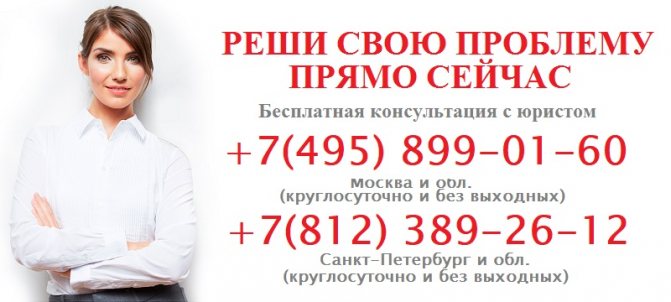
A citizen wishing to make an exchange will need to prepare and send a claim to the seller demanding a refund. The claim should be made in two copies, one of which is sent to the seller, and the second remains with the citizen.
At the top of the claim on the right, the following information is indicated:
- full legal name of the seller to whose address the claim is sent, as well as legal and actual addresses. You can find out this information from the financial documentation confirming the fact of payment for the goods, on the official websites of the seller or the Federal Tax Service;
- data of the citizen making the claim. The surname, first name and patronymic, registration and actual residence address, as well as a contact telephone number are indicated.
Attention! The main section of the claim contains the following information:
- a detailed description of the circumstances under which the goods were purchased. It is necessary to indicate where and when the goods were purchased, what the cost of this goods was. It is advisable to attach financial documentation confirming the fact of purchase of the goods;
- describe when and under what circumstances a defect was discovered in the product, and how the identified defect affects the use of the product. You should also indicate what other violations of consumer rights the seller committed;
- specific norms of the current legislation of the Russian Federation on which the consumer bases the put forward requirements. You can refer both to the norms enshrined in the Law of the Russian Federation of 02/07/1992 No. 2300 - I “On the Protection of Consumer Rights”, and to the norms of general civil legislation;
- specific requirements that the citizen seeks to satisfy.
The claim is sealed with the citizen’s handwritten signature with a transcript and indicating the date of signing.
There are the following ways to send a claim to the seller:
- personally. To do this, the citizen will need to come to the seller with two copies of the claim and ask the person authorized to receive incoming correspondence to accept the claim. In this case, it is necessary that the person who accepted the claim make a note of receipt on the citizen’s copy;
- by mail. The claim should be sent by registered mail with a list of attachments and acknowledgment of delivery.
A copy of the claim with a mark of receipt or a receipt note with a mark of receipt of the letter serves as evidence of the receipt of the claim by the seller. The need for this evidence will arise if the seller refuses to satisfy the citizen’s demands, and it will be necessary to go to court.
ATTENTION! Look at the completed sample claim for exchange of goods of good quality:
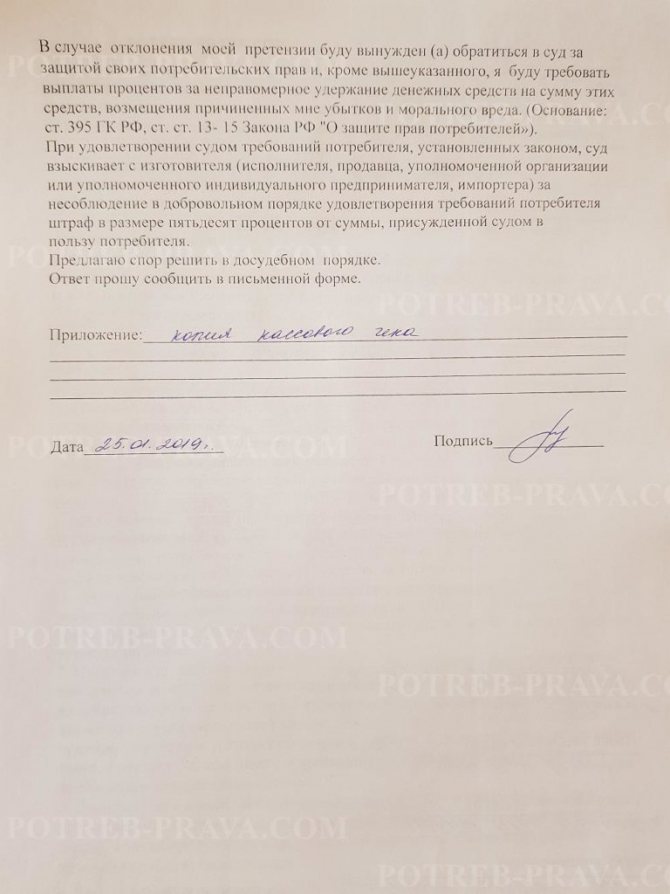
Duration of the procedure
The regulatory legal act defines the period for performing the action. Returns of goods of inadequate quality can be made within two weeks from the date of purchase. This is a sufficient period for the buyer to decide whether the item is suitable for him. Additionally, the person will be able to verify whether there are any flaws or defects that were not noticeable at the time of purchase. If the deadline has expired, the seller may refuse to consider the application.
By the way! If the established period has not expired, but the seller does not have similar products, the buyer acquires the right to terminate the sales contract and demand a refund. Refusal in this situation is considered unlawful.
It is permissible to carry out an exchange on the basis of an oral statement. However, the above action is at the discretion of the seller. In most cases, stores require a written application. The paper will need to indicate all the features of the purchase of the product and the reasons for the decision. The application must be prepared in two copies. One is provided to the seller, and the second remains with the buyer. On this copy of the application, the seller puts his signature and the date of acceptance of the application. Quality check can be done. In this situation, the replacement period reaches 20 days. If the period is long, a similar product may be transferred to the buyer for temporary use.
Video
Comments
- Only non-food products are subject to exchange and return;
- the right to exchange or return a product is not related to the violation of the buyer’s rights or the identification of defects in the product; such a right exists for the consumer regardless of the violations identified in his respect;
- the range of grounds on which the buyer has the right to demand an exchange of the item he purchased is exhaustive and closed - this is a discrepancy between the shape, cut, color, size or the presented configuration and the buyer’s expectations;
- the requirement for exchange or return is presented exclusively to the seller; neither the importer, nor the manufacturer, nor any other persons are obliged to fulfill the buyer’s specified desire;
- The 14-day period during which the buyer is allowed to exercise the right cannot be suspended, interrupted or restored for valid reasons, its duration is not affected by any circumstances, including the inability to use the purchased product;
- in the absence of a check or receipt confirming the purchase, the seller is not obliged to unequivocally trust the testimony presented in favor of the buyer - they are subject to objective evaluation, and if there is doubt about their reliability, the seller has the right to refuse;
- The buyer does not have the right, at the first contact, to make a demand to the seller to terminate the contract and return the money previously paid for the product. Within the meaning of the norm of paragraph 2 of Art. 25 of the PLA, this can only be done when a demand for an exchange was initially presented, but the seller could not satisfy it and refused it;
- The law establishes the seller’s obligation to notify the buyer about the receipt of goods for exchange, but does not establish liability for non-compliance. During the waiting period, the buyer is obliged to maintain the original appearance of the purchased product, otherwise he will lose the right to exchange.
Items that cannot be returned if their quality is as stated
The corresponding list is established by government decree No. 55.
The following goods of good quality cannot be returned:
- cosmetics, perfumes, child care products;
- furniture, vehicles;
- all goods in contact with food, technically complex goods used in everyday life;
- building materials, fabrics, wires sold by the meter;
- jewelry, weapons, ammunition;
- animals and plants;
- household chemicals and agricultural products;
- personal care and medical products;
- complex technical household goods.
Competent return
Initially, you will need to prepare a cash receipt or receipt provided by the seller. Returns will be processed within 14 days. The period begins to be calculated on the next day from the date of purchase. It is important that the appearance of the product, labels, shortcuts and necessary equipment are preserved.
Please note: Seller may inspect for damage, breakage or defects that would prevent further use. Once integrity has been verified, a statement will be required. You must provide a receipt confirming the purchase. If documents are missing, this is not a reason for refusing to consider the application.
Video
Article 25 Federal Law No. 2300-1: paragraph 1
In accordance with Art. 25 Federal Law No. 2300-1 ZZPP, any person who has purchased a non-food product - not food - is guaranteed the right to exchange it for a similar product, even if this product meets the requirements of the law and is of adequate quality. The seller is obliged to exchange the product presented by the buyer if it does not suit him for:
- form;
- I will cover;
- color palette;
- size;
- composition or configuration.
The buyer has the right to exchange such non-food product within 14 days from the date of purchase by presenting it at the point of sale. At the same time, the law provides for a number of conditions under which the exchange is considered permissible and possible:
- the buyer did not use the product for its intended purpose until it was presented to the seller;
- at the time the product is returned to the seller, it retains its properties and presentation, factory labels and other characteristics indicating its non-use;
- the buyer presents a sales receipt, receipt or other payment document confirming the fact of payment for the goods.
Note!
The buyer's absence of a check, receipt or other payment document is grounds for refusal of exchange. However, to confirm the fact of purchasing a product directly from this seller can be confirmed by testimony, in which case the seller has no right to refuse.
Government Decree No. 55 defines a list of non-food products for which this rule does not apply. Among them:
- medical devices and equipment, items for care and treatment of diseases outside medical institutions, medicines;
- personal hygiene products;
- cosmetics and perfumes;
- textiles, cables, construction and finishing and other goods sold by the meter;
- knitwear and neckwear products;
- polymer goods for transportation, storage and consumption of food;
- household and agricultural chemicals;
- furniture;
- jewelry;
- automobiles and motorcycles, ships and floating equipment for non-industrial purposes;
- technically complex products for everyday use;
- civilian weapons and ammunition;
- representatives of flora and fauna;
- printed materials of a non-periodic nature.
Drawing up an application
In order for the seller to consider the application, it is important to include a list of required information. The following data needs to be recorded:
- Seller details. It is important to reflect the full name of the organization, address and information for operational communication. The application must be made in the name of the manager.
- Buyer information. It is important to record personal data, place of residence, and information for prompt communication. Sometimes the seller requires that information contained in the passport be included.
- Document's name. In the middle of the sheet you will need to write the word “Application”.
- Circumstances of the purchase. It is necessary to enter data about the product itself, indicating its characteristics, and also record information about the reasons why the product was not suitable for the buyer.
- The requirements put forward. Replacement with a similar product. If the property is missing, you can ask the seller to terminate the purchase and sale agreement in advance and return the funds.
Claim form for refund of money for goods
The above list of information is not exhaustive. Additionally, you must provide the following information:
- delivery payment features;
- compensation for damage caused to the buyer due to the purchase of the wrong product, if the fault lies with the seller;
- performing repairs if defects are present;
- a list of documentation attached to the application and confirming the requirements put forward. Additionally, you need to put the date the paper was drawn up and sign.
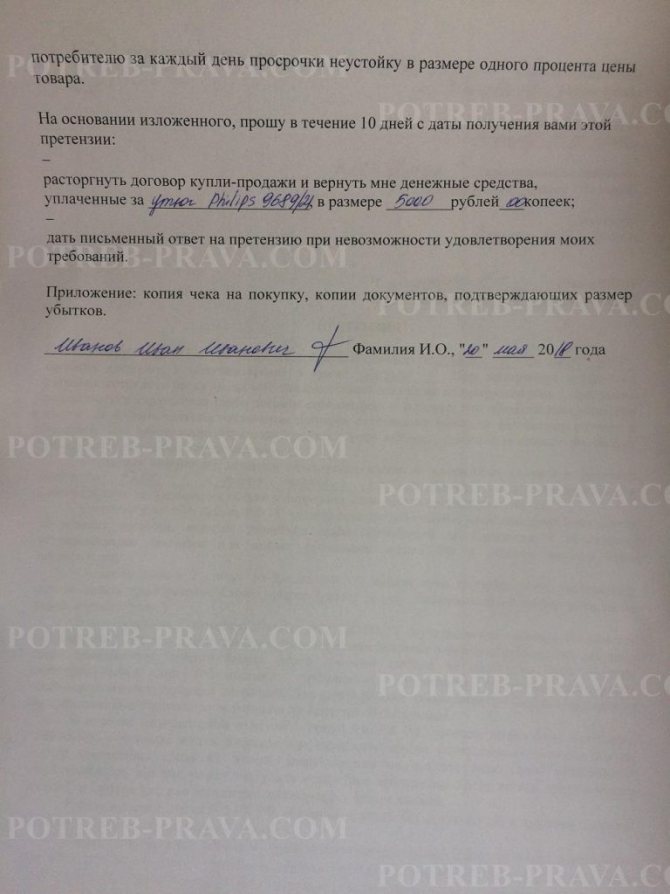
Review period and refund
In accordance with the norms enshrined in Part 1 of Article 31 of the Law of the Russian Federation of 02/07/1992 No. 2300 - I “On the Protection of Consumer Rights”, the seller is given 10 days to consider the claim on the merits and satisfy the requirements.
Let us note that in accordance with the norms of the current legislation of the Russian Federation, only state and municipal authorities are required to send a written response to citizens’ appeals.
Such an obligation is not imposed on commercial organizations, as well as individual entrepreneurs. Thus, the seller is not obliged to respond to the citizen in writing. But the lack of a response from the seller will not prevent a citizen from protecting his legal rights and interests.
The legislation on the protection of consumer rights establishes a norm according to which the seller is obliged to fulfill the legal requirements of the consumer within the time limits established in the Law of the Russian Federation of 02/07/1992 No. 2300 - I “On the Protection of Consumer Rights”. The countdown of these deadlines begins from the moment the claim is delivered to the seller.
Important! The Law of the Russian Federation dated 02/07/1992 No. 2300 - I “On the Protection of Consumer Rights” establishes the following deadlines:
- 10 days to satisfy the request for a refund;
- 30 days to exchange goods for an equivalent one.
This is why it is so important to establish the date the seller received the claim. It is from this date that the period for satisfying the requirements will be calculated.
How to get a refund for a fitness club membership?
What to do if you were deceived in an online store: how to get your money back, read here.
How to return a fur coat purchased at the market, read the link:
Filing a claim
If the seller refuses to satisfy the demands voluntarily, legal proceedings can be initiated. For this purpose, a statement of claim is being prepared.
To be considered, you will need to provide the following information:
- information about the institution that will consider the issue;
- information about the plaintiff and defendant;
- data on the cost of the claims put forward;
- features of what happened;
- put forward requirements.
There is no need to pay state duty.
Claim form for return of goods
The statement of claim must be supplemented with all available written evidence. They will allow you to confirm the arguments put forward.
Arbitrage practice
The statement of claim of L.L. Marchenko was sent to the court of second instance. on the cancellation of the verdict of the court of first instance, which satisfied the requests of Samoilov I.V. on payment of penalties and compensation for moral damage. The reason for such an application was the fact that he purchased the phone from the seller without checking the quality and warranty period, but did not use the purchased item within a two-week period. After this period, he decided to return it, citing the fact that his wife did not like the device because it was the wrong color. He presented the fact that he did not use it for its intended purpose: the packaging was intact, unopened, the technical passport was still there. The court of first instance approved the claim of Samoilov I.V., and accordingly ordered the seller to pay a penalty and compensation for moral damage.

The seller does not agree with this decision, so he went to court to review the case, substantiating his claims. Namely:
- the buyer did not want to check the quality of the purchase;
- did not use it for its intended purpose;
- exceeded the time allotted for the exchange of the item purchased.
The Supreme Court decided to annul the verdict of the trial court. The clarification indicates that some of the facts were not considered. The decision was made according to the testimony of witnesses, to which the applicant I.V. Samoilov referred.




